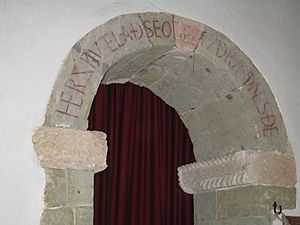Wynn facts for kids
Quick facts for kids Ƿ |
|
|---|---|
| Ƿ ƿ | |
| (See below) | |
 |
|
| Usage | |
| Writing system | Futhorc |
| Type | Alphabetic and Logographic |
| Language of origin | Old English language |
| Phonetic usage | [w] /wɪn/ |
| Unicode value | U+01F7, U+01BF |
| History | |
| Development |
ᚹ
|
| Time period | ~700 to ~1100 |
| Descendants | Ꝩ ꝩ |
| Sisters | None |
| Transliteration equivalents | w |
| Variations | (See below) |
| Other | |
| Other letters commonly used with | w |
| Name | Proto-Germanic | Old English |
|---|---|---|
| *Wunjō | Wynn | |
| "joy" | ||
| Shape | Elder Futhark | Futhorc |
| Unicode | ᚹ
U+16B9
|
|
| Transliteration | w | |
| Transcription | w | |
| IPA | [w] | |
| Position in rune-row |
8 | |
Wynn (Ƿ ƿ), also spelled wyn or wen, is an old letter. It was part of the Old English alphabet. People used it to write the "w" sound, like in the word "water."
Contents
History of Wynn
How the Letter "W" Developed
When people first wrote in Old English, they often used two "u" letters together (uu) for the "w" sound. But soon, writers started using a special symbol called a rune. This rune was called wynn (ᚹ).
Wynn became a regular letter during the Anglo-Saxon period. This was a time in English history from about 450 AD to 1066 AD. Over time, around the 1300s, people stopped using wynn. Instead, they went back to using uu, which eventually turned into our modern letter "w".
What Wynn Means
The rune wynn has a special meaning. It stands for "joy" or "happiness." We know this from old poems called the Anglo-Saxon Rune Poems.
One part of these poems says:
ᚹ Ƿenne brūceþ, þe can ƿēana lẏt
sāres and sorge and him sẏlfa hæf
blǣd and blẏsse and eac bẏrga geniht.
This means:
Who uses it knows no pain,
sorrow nor anxiety, and he himself has
prosperity and bliss, and also enough shelter
It shows that the letter was linked to good feelings and good fortune.
Other Uses of Wynn
The wynn rune was not used in later runic alphabets. However, in the Gothic alphabet, there was a letter (𐍅) called winja. This name also means "joy."
Wynn is one of only two runes that became part of the English alphabet. The other is thorn (þ), which made the "th" sound. A changed version of wynn, called vend, was used for a short time in Old Norse. This was another old language from Northern Europe.
Today, when people print old English texts, they sometimes bring back the letter wynn. But usually, they just use the modern "w" instead.
Images for kids
See also
- Digamma
- Eth
- Meldorf fibula
- Thorn (letter)
- Vend (letter)
- Yogh
- Ỽ



